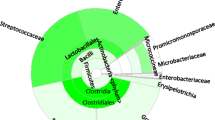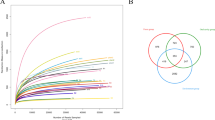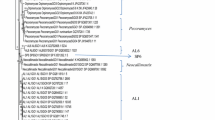Abstract
The interaction between termites and their gut symbionts has continued to attract the curiosity of researchers over time. The aim of this study was to characterize and compare the bacterial diversity and community structure in the guts of three termites (Odontotermes somaliensis, Odontotermes sp. and Microtermes sp.) using 16S rRNA gene sequencing of clone libraries. Clone libraries were screened by restriction fragment length polymorphism and representative clones from O. somaliensis (100 out of 330 clones), Odontotermes sp. (100 out of 359 clones) and Microtermes sp. (96 out 336 clones) were sequenced. Phylogenetic analysis indicated seven bacterial phyla were represented: Bacteroidetes, Spirochaetes, Firmicutes, Proteobacteria, Synergistetes, Planctomycetes and Actinobacteria. Sequences representing the phylum Bacteroidetes (>60 %) were the most abundant group in Odontotermes while those of Spirochaetes (29 %) and Firmicutes (23 %) were the abundant groups in Microtermes. The gut bacterial community structure within the two Odontotermes species investigated here was almost identical at the phylum level, but the Microtermes sp. had a unique bacterial community structure. Bacterial diversity was higher in Odontotermes than in Microtermes. The affiliation and clustering of the sequences, often with those from other termites’ guts, indicate a majority of the gut bacteria are autochthonous having mutualistic relationships with their hosts. The findings underscore the presence of termite-specific bacterial lineages, the majority of which are still uncultured.





Similar content being viewed by others
References
Ahmed BM, Nkunika POY, Sileshi WG, French JRJ, Nyeko P, Jain S (2011) Potential impact of climate change on termite distribution in Africa. Br J Environ Clim Chang 1:172–189
Altschul SF, Gish W, Miller W et al (1990) Basic local alignment search tool. J Mol Biol 215:403–410
Ashelford KE, Chuzhanova NA, Fry JC, Jones AJ, Weightman AJ (2006) New screening software shows that most recent large 16S rRNA gene clone libraries contain chimeras. Appl Environ Microbiol 72:5734–5741
Austin JW, Szalanski AL, Cabrera BJ (2004) Phylogenetic analysis of the subterranean termite family Rhinotermitidae (Isoptera) by using the mitochondrial cytochrome oxidase II gene. Ann Entomol Soc Am 97:548–555
Ausubel FM (1995) Current protocols in molecular biology. Wiley, New York
Ballor NR, Paulsen I, Leadbetter JR (2012) Genomic analysis reveals multiple [FeFe] hydrogenases and hydrogen sensors encoded by treponemes from the H2-rich termite gut. Microb Ecol 63:282–294
Bayer EA, Lamed R, White BA, Flint HJ (2008) From cellulosomes to cellulosomics. Chem Rec 8:364–377
Breznak JA (1984) Hindgut spirochaetes of termites and Cryptocercus puntulatus. In: Krieg NR, Holt JG (eds) Bergey’s manual of systematic bacteriology, vol 1. Williams & Wilkins, Baltimore, pp 67–70
Breznak JA (2000) Ecology of prokaryotic microbes in the guts of wood- and litter-feeding termites. In: Abe T, Bignell DE, Higashi M (eds) Termites: evolution, sociality, symbiosis, ecology. Kluwer, Dordrecht, pp 209–231
Brune A, Friedrich M (2000) Microecology of the termite gut: structure and function on a microscale. Curr Opin Microbiol 3:263–269
Brune A, Ohkuma M (2011) Role of the termite gut microbiota in symbiotic digestion. In: Bignell DE, Roisin Y, Lo N (eds) Biology of termites: a modern synthesis. Springer, Dordrecht, pp 439–475
Brune A, Ludwig W, Schink B (2002) Propionivibrio limicola sp. nov., a fermentative bacterium specialized in the degradation of hydroaromatic compounds, reclassification of Propionibacter pelophilus as Propionivibrio pelophilus comb. nov. and amended description of the genus Propionivibrio. Int J Syst Evol Microbiol 52:441–444
Bulmer MS, Crozier RH (2004) Duplication and diversifying selection among termite antifungal peptides. Mol Biol Evol 21:2256–2264
Cole JR, Chai B, Farris RJ et al (2005) The Ribosomal Database Project (RDP-II): sequences and tools for high-throughput rRNA analysis. Nucleic Acids Res 33:D294–D296
Curtis TP, Sloan WT (2004) Prokaryotic diversity and its limits: microbial community structure in nature and implications for microbial ecology. Curr Opin Microbiol 7:221–226
Dahle H, Birkeland NK (2006) Thermovirga lienii gen. nov., sp. nov., a novel moderately thermophilic, anaerobic, amino-acid-degrading bacterium isolated from a North Sea oil well. Int J Syst Evol Microbiol 56:1539–1545
Farris MH, Olson JB (2007) Detection of actinobacteria cultivated from environmental samples reveals bias in universal primers. Lett Appl Microbiol 45:376–381
Felsenstein J (1985) Confidence limits on phylogenies: an approach using the bootstrap. Evolution 39:783–791
Fisher M, Miller D, Brewster C, Husseneder C, Dickerman A (2007) Diversity of gut bacteria of Reticulitermes flavipes as examined by 16S rRNA gene sequencing and amplified rDNA restriction analysis. Curr Microbiol 55:254–259
Giuliano C, Khan AW (1984) Cellulase and sugar formation by Bacteroides cellulosolvens, a newly isolated cellulolytic anaerobe. Appl Environ Microbiol 48:446–448
Graber JR, Leadbetter JR, Breznak JA (2004) Description of Treponema azotonutricium sp. nov. and Treponema primitia sp. nov., the first spirochetes isolated from termite guts. Appl Environ Microbiol 70:1315–1320
Hansen PS, Jensen TG, Gahrn-Hansen B (2005) Dysgonomonas capnocytophagoides bacteraemia in a neutropenic patient treated for acute myeloid leukaemia. APMIS 113:229–231
Hongoh Y, Ohkuma M, Kudo T (2003) Molecular analysis of bacterial microbiota in the gut of the termite Reticulitermes speratus (Isoptera; Rhinotermitidae). FEMS Microbiol Ecol 44:231–242
Hongoh Y, Deevong P, Inoue T, Moriya S, Trakulnaleamsai S, Ohkuma M, Vongkaluang C, Noparatnaraporn N, Kudo T (2005) Intra- and interspecific comparisons of bacterial diversity and community structure support coevolution of gut microbiota and termite host. Appl Environ Microbiol 71:6590–6599
Hongoh Y, Ekpornprasit L, Inoue T, Moriya S, Trakulnaleamsai S, Ohkuma M, Noparatnaraporn N, Kudo T (2006) Intracolony variation of bacterial gut microbiota among castes and ages in the fungus-growing termite Macrotermes gilvus. Mol Ecol 15:505–516
Inward DJG, Vogler AP, Eggleton P (2007) A comprehensive phylogenetic analysis of termites (Isoptera) illuminates key aspects of their evolutionary biology. Mol Phylogenet Evol 44:953–967
Kodama Y, Shimoyama T, Watanabe K (2012) Dysgonomonas oryzarvi sp. nov., isolated from a microbial fuel cell. Int J Syst Evol Microbiol 62(12):3055–3059. doi:10.1099/ijs.0.039040-0
Köhler T, Dietrich C, Scheffrahn RH, Brune A (2012) High-resolution analysis of gut environment and bacterial microbiota reveals functional compartmentation in the gut of wood-feeding higher termites (Nasutitermes spp.). Appl Environ Microbiol 78:4691–4701
Könönen E, Song Y, Rautio M, Finegold SM (2010) Genus II. Alistipes. In: Krieg NR, Staley JT, Brown DR, Hedlund BP, Paster BJ, Ward NL, Ludwig W, Whitman W (eds) Bergey’s manual of systematic bacteriology 4, 2nd edn. Springer, New York, pp 84–88
Kuhnigk T, Branke J, Krekeler D, Cypionka H, König H (1996) A feasible role of sulfate-reducing bacteria in the termite gut system. Appl Microbiol 19:139–149
Lane DJ (1991) 16S/23S rRNA sequencing. In: Stackebrandt E, Goodfellow M (eds) Nucleic acid techniques in bacterial systematics. Wiley, New York, pp 115–175
Le Roes-Hill M, Rohland J, Burton S (2011) Actinobacteria isolated from termite guts as a source of novel oxidative enzymes. Antonie Van Leeuwenhoek 100:589–605
Lilburn TG, Kim KS, Ostrom NE, Byzek KR, Leadbetter JR, Breznak JA (2001) Nitrogen fixation by symbiotic and free-living spirochetes. Science 292:2495–2498
Liu N, Yan X, Zhang M, Xie L, Wang Q, Huang Y, Zhou X, Wang S, Zhou Z (2011) Microbiome of fungus-growing termites: a new reservoir for lignocellulase genes. Appl Environ Microbiol 77:48–56
Long Y-H, Xie L, Liu N, Yan X, Li M-H, Fan M-Z, Wang Q (2010) Comparison of gut-associated and nest-associated microbial communities of a fungus-growing termite (Odontotermes yunnanensis). J Insect Sci 17:265–276
Mackenzie LM, Muigai AT, Osir EO, Lwande W, Keller M, Toledo G, Boga HI (2007) Bacterial diversity in intestinal tract of fungus-cultivating termite Macrotermes michaelseni (Sjöestedt). Afr J Biotechnol 6:658–667
Makonde HM, Boga HI, Osiemo Z, Mwirichia R, Stielow B, Göker M, Klenk H-P (2013) Diversity of Termitomyces associated with fungus-farming termites assessed by cultural and culture-independent methods. PLoS ONE 8:e56464. doi:10.1371/journal.pone.0056464
Mathew GM, Ju Y-M, Lai C-Y, Mathew DC, Huang CC (2012) Microbial community analysis in the termite gut and fungus comb of Odontotermes formosanus: the implication of Bacillus as mutualists. FEMS Microbiol Ecol 79:504–517
Mattéotti C, Thonart P, Francis F, Haubruge E, Destain J, Brasseur C, Bauwens J, De Pauw E, Portetelle D, Vandenbol M (2011) New glucosidase activities identified by functional screening of a genomic DNA library from the gut microbiota of the termite Reticulitermes santonensis. Microbiol Res 166:629–642
Matthies C, Gößner A, Acker G, Schramm A, Drake HL (2004) Lactovum miscens gen. nov., sp. nov., an aerotolerant, psychrotolerant, mixed-fermentative anaerobe from acidic forest soil. Res Microbiol 155:847–854
Moriya S, Inoue T, Ohkuma M, Yaovapa T, Johjima T, Suwanarit P, Sangwani U, Vongkaluang C, Noparatnaraporn N, Kudo T (2005) Fungal community analysis of fungus gardens in termite nests. Microbes Environ 20:243–252
Nagai F, Morotomi M, Watanabe Y, Sakon H, Tanaka R (2010) Alistipes indistinctus sp. nov. and Odoribacter laneus sp. nov., common members of the human intestinal microbiota isolated from faeces. Int J Syst Evol Microbiol 60:1296–1302
Norris SJ, Paster BJ, Smibert RM (2010) Genus IV. Treponema. In: Krieg NR, Staley JT, Brown DR, Hedlund BP, Paster BJ, Ward NL, Ludwig W, Whitman W (eds) Bergey’s manual of systematic bacteriology 4, 2nd edn. Springer, New York, pp 529–550
Ohkuma M, Shimizu H, Thongaram T, Kosono S, Moriya K, Trakulnaleamsai S, Noparatnaraporn N, Kudo T (2003) An alkaliphilic and xylanolytic Paenibacillus species isolated from the gut of a soil-feeding termite. Microbes Environ 18:145–151
Pasti MR, Belli ML (1985) Cellulolytic activities of actinomycetes isolates from termites (Termitinae) gut. FEMS Microbiol Lett 26:107–112
Pasti MB, Pometto AL III, Nuti MP, Crowford DL (1990) Lignin-solubilizing ability of actinomycetes isolated from termite (Termitidae) gut. Appl Environ Microbiol 56:2213–2218
Riviere D, Desvignes V, Pelletier E, Chaussonnerie S, Guermazi S, Weissenbach J, Li T, Camacho P, Sghir A (2009) Towards the definition of a core of microorganisms involved in anaerobic digestion of sludge. ISME J 3:700–714
Saitou N, Nei M (1987) The neighbor-joining method: a new method for reconstructing phylogenetic trees. Mol Biol Evol 4:406–425
Sanyika TW, Rashamuse KJ, Hennessy F, Brady D (2012) Luminal hindgut bacterial diversities of the grass and sugarcane feeding termite Trinervitermes trinervoides. Afr J Microbiol Res 6:2639–2648
Saulnier DM, Riehle K, Mistretta TA, Diaz MA, Mandal D, Raza S, Weidler EM, Qin X, Coarfa C, Milosavljevic A et al (2011) Gastrointestinal microbiome signatures of pediatric patients with irritable bowel syndrome. Gastroenterology 141:1782–1791
Schauer C, Thompson CL, Brune A (2012) The bacterial community in the gut of the cockroach Shelfordella lateralis reflects the close evolutionary relatedness of cockroaches and termites. Appl Environ Microbiol 78:2758–2767
Schmitt-Wagner D, Friedrich MW, Wagner B, Brune A (2003) Phylogenetic diversity, abundance, and axial distribution of bacteria in the intestinal tracts of two soil-feeding termites (Cubitermes spp.). Appl Environ Microbiol 69:6007–6017
Shinzato N, Muramatsu M, Matsui T, Watanabe Y (2005) Molecular phylogenetic diversity of the bacterial community in the gut of the termite Coptotermes formosanus. Biosci Biotechnol Biochem 69:1145–1155
Shinzato N, Muramatsu M, Matsui T, Watanabe Y (2007) Phylogenetic analysis of the gut bacterial microflora of the fungus-growing termite Odontotermes formosanus. Biosci Biotech Biochem 71:906–915
Sonnenburg ED, Zheng H, Joglekar P, Higginbottom SK, Firbank SJ, Bolam DN, Sonnenburg JL (2010) Specificity of polysaccharide use in intestinal Bacteroides species determines diet-induced microbiota alterations. Cell 141:1241–1252
Tamura K, Nei M, Kumar S (2004) Prospects for inferring very large phylogenies by using the neighbour-joining method. Proc Natl Acad Sci USA 101:11030–11035
Tamura K, Peterson D, Peterson N, Stecher G, Nei M, Kumar S (2011) MEGA5: molecular evolutionary genetics analysis using maximum likelihood, evolutionary distance, and maximum parsimony methods. Mol Biol Evol 28:2731–2739
Tanaka H, Aoyagi H, Shina S, Dodo Y, Yoshimura T, Nakamura R, Uchiyama H (2006) Influence of the diet components on the symbiotic microorganisms community in hindgut of Coptotermes formosanus Shiraki. Appl Environ Biotechnol 71:907–917
Tartar A, Wheeler MM, Zhou X, Coy MR, Boucias DG, Scharf ME (2009) Parallel metatranscriptome analyses of host and symbiont gene expression in the gut of the termite Reticulitermes flavipes. Biotechnol Biofuels 2:25
Vartoukian SR, Palmer RM, Wade WG (2007) The division “Synergistes”. Anaerobe 13:99–106
Visser AA, Nobre T, Currie CR, Aanen DK, Poulsen M (2012) Exploring the potential for actinobacteria as defensive symbionts in fungus-growing termites. Microb Ecol 63:975–985
von Wintzingerode F, Göbel UB, Stackebrandt E (1997) Determination of microbial diversity in environmental samples: pitfalls of PCR-based rRNA analysis. FEMS Microbiol Rev 21:213–229
Warnecke F, Luginbuhl P, Ivanova N, Ghassemian M, Richardson TH, Stege JT, Cayouette M, McHardy AC, Djordjevic G, Aboushadi N, Sorek R, Tringe SG, Podar M, Martin HG, Kunin V, Dalevi D, Madejska J, Kirton E, Platt D, Szeto E, Salamov A, Barry K, Mikhailova N, Kyrpides NC, Matson EG, Ottesen EA, Zhang X, Hernández M, Murillo C, Acosta LG, Rigoutsos I, Tamayo G, Green BD, Chang C, Rubin EM, Eric J, Mathur EJ, Robertson DE, Hugenholtz P, Leadbetter JR (2007) Metagenomic and functional analysis of hindgut microbiota of a wood-feeding higher termite. Nature 450:560–565
Watanabe Y, Shinzato N, Fukatsu T (2003) Isolation of actinomycetes from termites’ guts. Biosci Biotechnol Biochem 67:1797–1801
Werren JH, Baldo L, Clark ME (2008) Wolbachia: master manipulators of invertebrate biology. Nat Rev Microbiol 6:740–751
Wexler HM (2007) Bacteroides: the good, the bad, and the nitty-gritty. Clin Microbiol Rev 20:593–621
Xu J, Bjursell MK, Himrod J, Deng S, Carmichael LK, Chiang HC, Hooper LV, Gordon JI (2003) A genomic view of the human Bacteroides thetaiotaomicron symbiosis. Science 299:2074–2076
Zhu YY, Li J, Liu H, Yang H, Xin S, Zhao F, Zhang X, Tian Y, Lu X (2012) Phylogenetic analysis of the gut bacterial microflora of the fungus-growing termite Macrotermes barneyi. Afr J Microbiol Res 6:2071–2078
Acknowledgments
This work was supported by a Ph.D. scholarship from the Deutscher Akademischer Austauschdienst (DAAD) and a Grant (NCST/5/003/PG/224) from the Kenya National Council for Science and Technology (NCST). Kenya Wildlife Services (KWS) and National Environmental Management Act (NEMA) provided permits for sample collection in Kenya. We kindly thank J. Simon, G. Gresenz, M. Scharfe and S. Schmidt for excellent technical support.
Author information
Authors and Affiliations
Corresponding author
Electronic supplementary material
Below is the link to the electronic supplementary material.
Rights and permissions
About this article
Cite this article
Makonde, H.M., Boga, H.I., Osiemo, Z. et al. 16S-rRNA-based analysis of bacterial diversity in the gut of fungus-cultivating termites (Microtermes and Odontotermes species). Antonie van Leeuwenhoek 104, 869–883 (2013). https://doi.org/10.1007/s10482-013-0001-7
Received:
Accepted:
Published:
Issue Date:
DOI: https://doi.org/10.1007/s10482-013-0001-7




